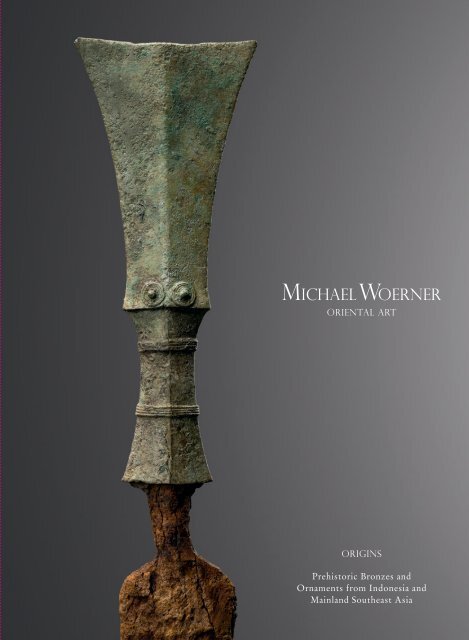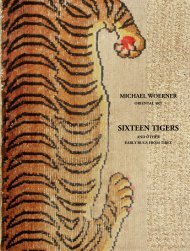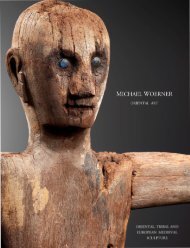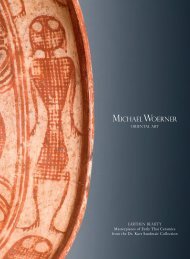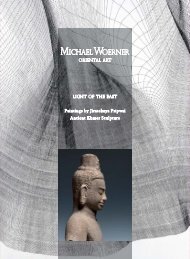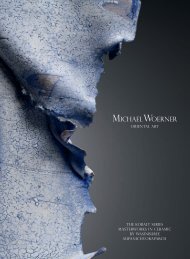You also want an ePaper? Increase the reach of your titles
YUMPU automatically turns print PDFs into web optimized ePapers that Google loves.
Michael Woerner<br />
ORIENTAL ART<br />
<strong>ORIGINS</strong><br />
Prehistoric Bronzes and<br />
Ornaments from Indonesia and<br />
Mainland Southeast Asia
<strong>MICHAEL</strong> <strong>WOERNER</strong><br />
Oriental Art<br />
<strong>2018</strong><br />
1
M i c h a e l Woerner<br />
Oriental Art <strong>2018</strong><br />
<strong>ORIGINS</strong><br />
Prehistoric Bronzes and<br />
Ornaments from Indonesia and<br />
Mainland Southeast Asia<br />
Bangkok · Hong Kong<br />
By appointment<br />
Tel. +66-89-224.9678<br />
micwoerner@yahoo.com<br />
3
Within the circle of Tribal Art fairs worldwide, the Tribal Art Fair <strong>Amsterdam</strong> has<br />
<strong>for</strong> many years cultivated and preserved its very own, distinguished position. It is<br />
not a blue print copy of the standardized art fairs in New York, Paris or Brussels.<br />
It intends to be different, of a “human” scale, personal, approachable, easily likeable<br />
and with a wonderful local Dutch ambience. Treasures can be found here year<br />
after year, at still reasonable prices. And indeed, merchants from New York,<br />
Paris and Brussels, even Australia and Asia flock in to find works of art <strong>for</strong> future<br />
exhibitions of their own.<br />
It is a great delight <strong>for</strong> us to participate in this event<br />
<strong>for</strong> the first time. As this is primarily a Tribal Art<br />
Fair with a strong emphasis on Indonesia and<br />
Oceania, the eminent merchant Loed van Bussel,<br />
who sadly passed away earlier this year, once<br />
suggested to entice its visitors with something<br />
“new”: a small, focused exhibition on the roots<br />
of Tribal Art in Indonesia & Oceania. After our<br />
widely acclaimed 2015 exhibition in Brussels<br />
“Dong Son – The Image of Man and Animal in<br />
Early Southeast Asia”, we have the great pleasure to<br />
present in <strong>Amsterdam</strong> “Origins – Prehistoric<br />
Bronzes and Ornaments from Indonesia and<br />
Mainland Southeast Asia”. May this small<br />
publication be our heartfelt dedication to Loed.<br />
All objects have been sourced from private<br />
collections in Europe, Asia and the U.S.A. Several<br />
of these objects have previously been published<br />
or exhibited in museum shows. As always, every<br />
object is accompanied by a detailed documentation.<br />
Loed van Bussel (1935 – <strong>2018</strong>)<br />
We look <strong>for</strong>ward to seeing you in <strong>Amsterdam</strong>.<br />
<strong>MICHAEL</strong> <strong>WOERNER</strong><br />
<strong>Amsterdam</strong>, <strong>October</strong> <strong>2018</strong><br />
4
<strong>ORIGINS</strong><br />
Prehistoric Bronzes And Ornaments<br />
From Indonesia And Mainland Southeast Asia<br />
Current scholarship places the beginnings of the Bronze Age in Mainland Southeast<br />
Asia into the first half of the first millennium BCE, possibly slightly later in Island<br />
Southeast Asia, today’s Indonesia and the Philippines. The term “Dong Son Culture”,<br />
coined after the type-site in Northern Viet Nam, has generally been used as a<br />
catch-all term <strong>for</strong> the Southeast Asian Bronze Age. This approach is now under<br />
revision.<br />
Top: Detail of a Pejeng-type Drum (see p. 16).<br />
Java, Bronze/ Iron Age, circa 300 BCE – 200 CE.<br />
Bronze. Width of face circa 12cm.<br />
Archaeological research shows that the bronze<br />
casting technology spread fairly quickly through<br />
Southeast Asia, most likely by trade, inspiration and<br />
wandering craftsmen. But even though technology<br />
was shared, the final products often display<br />
individual styles of insular societies. This is in<br />
particular evident in Indonesia, to where large<br />
Vietnamese “Dong Son” drums were traded, but<br />
where also numerous local products emerged. The<br />
so-called “Pejeng-type” drums share only a few<br />
similarities with their probable inspirations from<br />
Viet Nam. Bronze Age production places in Java<br />
and Bali very quickly developed their own decorative<br />
design language, adjusted to local demands. Chance<br />
finds in Borneo, Sulawesi, the Moluccas and Irian<br />
Jaya only confirm this.<br />
Similarities of fairly complex designs on some<br />
Indonesian Bronze Age objects and 1500 - 2000 years<br />
later wood carvings have often invited speculations<br />
about the continuity of ancient traditions<br />
into the present. Political, trade and religious influences<br />
from the 5 th to the 18 th and even 19 th century<br />
apparently had only a limited influence on the<br />
spiritual world of these islands. Ancient traditions<br />
and beliefs, developed since Prehistoric times,<br />
persisted.<br />
Bottom: Coffin end. Borneo, Bahau Dayak, Out of the numerous examples <strong>for</strong> such a<br />
Wood. C14-dated 17th cent. CE. W circa 40 cm. persistence, we would like to pick here just one.<br />
Private collection. Image courtesy Frank Wiggers. When juxtaposed with a detail of a Pejeng-type<br />
drum from Java (top photo on this page; see also<br />
p. 16), the face of a wood-carved coffin end from the Bahau Dayak of Borneo<br />
(bottom photo on this page) is of a striking similarity.<br />
With our exhibition we try to shed some additional light onto this fascinating<br />
field by displaying a small and diverse group of mostly unpublished bronzes and<br />
ornaments from Indonesia and Mainland Southeast Asia.<br />
5
FUNERARY MASK<br />
Indonesia, Java, Bronze/ Iron Age,<br />
Circa 300 BCE – 200 CE<br />
Gold. Height 13.2 cm<br />
Provenance: Private Collection Netherlands<br />
(since the 1970s)<br />
6
FUNERARY MASK<br />
Indonesia, Java, Bronze/ Iron Age,<br />
Circa 300 BCE – 200 CE<br />
Gold. Height 8.6 cm<br />
Provenance: Private Collection Netherlands<br />
(since the 1970s)<br />
7
MAMMAL-SHAPED HANDLE<br />
Indonesia, Java, purportedly from Lumajang area<br />
Bronze/ Iron Age, circa 300 BCE – 200 CE<br />
Bronze. Length 8.4 cm<br />
Provenance: Collection of the late Dr K. Sandmair, Munich<br />
(since the 1980s)<br />
8
WARRIOR WITH LONG SWORD<br />
Indonesia, Java, purportedly from Lumajang area<br />
Bronze/ Iron Age, circa 300 BCE – 200 CE<br />
Bronze. Height 11.2 cm<br />
Provenance: Collection of the late Dr K. Sandmair, Munich<br />
(since the 1980s)<br />
9
LADLE WITH RATTLE AND COCK FINIAL<br />
Indonesia, Java, Bronze/ Iron Age<br />
Circa 300 BCE – 200 CE<br />
Bronze. Length 27 cm<br />
Provenance: Collection of the late<br />
Dr K. Sandmair, Munich<br />
(since the 1980s)<br />
10
ANTHROPOMORPHIC LIME CONTAINERS<br />
Indonesia, Java, Bronze/ Iron Age,<br />
Circa 300 BCE – 200 CE<br />
Bronze. Height 9.5 cm and 18.5 cm<br />
Provenance: Private Collection U.S.A. (since 1980s).<br />
Exhibited: Legacies - Masterpieces of Indonesian Art.<br />
Pinacotheque Singapore, May 2015 – May 2016<br />
11
SWORD WITH ANTHROPOMORPHIC<br />
HANDLE<br />
Indonesia, Java, Iron Age,<br />
Circa 100 BCE – 200 CE<br />
Bronze handle, iron blade<br />
Length 69.5 cm<br />
Provenance: Private Collection<br />
Japan (since 1980s)<br />
12
CEREMONIAL HALBERD (CANDRASA)<br />
Indonesia, Eastern Java, Bronze/ Iron Age,<br />
Circa 300 BCE – 200 CE<br />
Bronze. Length 45 cm<br />
Provenance: Private Collection Japan (since 1980s)<br />
13
DOUBLE-POINTED AXE<br />
WITH ANIMAL HEADS<br />
Indonesia, Java, Bronze/ Iron Age,<br />
Circa 300 BCE – 200 CE<br />
Bronze. Length 23 cm. Width 20.5 cm<br />
Provenance: Private Collection, Singapore (since 1980s)<br />
14
LARGE BELL WITH TWO ELEPHANTS<br />
Thailand, purportedly from Chaiyapum area<br />
Bronze Age, circa 500 BCE – 100 BCE<br />
Bronze. Height 34.2 cm<br />
Provenance: Collection of the late Dr K. Sandmair, Munich (since the 1980s)<br />
15
PEJENG-TYPE DRUM<br />
Fragment with stylized faces<br />
Indonesia, Java, Bronze/ Iron Age,<br />
Circa 300 BCE – 200 CE<br />
Bronze. Length 51 cm<br />
Provenance: Private Collection U.S.A. (since 1980s).<br />
Published: Bruce W. Carpenter, Indonesian Tribal Art. The Rodger Dashow Collection<br />
(Singapore: Editions Didier Millet, 2012), p. 26.<br />
16
PEJENG-TYPE DRUM<br />
An extraordinary tympanum with a pair<br />
of mythical winged dragons<br />
Indonesia, Java, Bronze/ Iron Age, circa 300 BCE – 200 CE<br />
Bronze. Diameter 46 cm. Height 33 cm<br />
Provenance: Private Collection U.S.A. (since 1980s)<br />
Exhibited: Legacies - Masterpieces of Indonesian Art.<br />
Pinacotheque Singapore, May 2015 – May 2016<br />
17
ANKLETS<br />
Indonesia, Eastern Java, Bronze/ Iron Age,<br />
Circa 300 BCE – 200 CE<br />
Bronze. Diameter 18 cm<br />
Provenance: Private Collection Netherlands<br />
(since the 1970s)<br />
18
SHARK VERTEBRAE NECKLACE<br />
Indonesia, Java, Bronze/ Iron Age,<br />
Circa 300 BCE – 200 CE<br />
Consisting of 36 semi-fossilized shark vertebrae<br />
Provenance: Collection of the late Dr K. Sandmair, Munich (since the 1980s)<br />
19
BUST OF AN ANCESTOR FIGURE<br />
Indonesia, Southeast Sulawesi<br />
Circa 1st half of 1st millennium CE<br />
Terracotta. Height: 14 cm<br />
Provenance: Private Collection Japan (since 1980s)<br />
20
JAR LID WITH HUMAN HEAD<br />
Indonesia, Southeast Sulawesi<br />
Circa 1st half of 1st millennium CE<br />
Pottery with red and yellow pigments.<br />
Height 13 cm. Diameter 18 cm<br />
Provenance: Private Collection U.S.A. (since 1980s)<br />
21
ACKNOWLEDGEMENTS<br />
For their trust and cooperation in the past 29 years, we would like to express our<br />
gratitude to the following institutions:<br />
Rautenstrauch-Joest-Museum, Cologne<br />
Museum der Insel Hombroich, Neuss-Holzheim<br />
Linden-Museum, Sxtuttgart<br />
Staatliches Museum für Völkerkunde, Munich<br />
Musée Barbier-Mueller, Genève<br />
Museum der Kulturen, Basel<br />
Rietberg-Museum, Zuerich<br />
Musée des Arts Asiatiques Guimet, Paris<br />
Musée des Arts Asiatiques, Nice<br />
Musées Royaux d‘Art et d‘Histoire, Brussels<br />
The Victoria and Albert Museum, London<br />
The British Museum, London<br />
The British Library, London<br />
The Ashmolean Museum of Art and Archaeology, Ox<strong>for</strong>d<br />
Asian Civilisations Museum, Singapore<br />
Indian Heritage Trust, Singapore<br />
Bangkok University Museum, Bangkok<br />
The Prasart Museum, Bangkok<br />
The Bangkok Insurance Museum, Bangkok<br />
The Suan Pakkad Palace Collection, Bangkok<br />
T. T. Tsui Museum of Art, Hong Kong<br />
The Ayala Museum, Manila<br />
The Tokyo National Museum, Tokyo<br />
Matsuoka Museum of Art, Tokyo<br />
Idemitsu Museum, Tokyo<br />
The Museum Yamato Bunkakan, Nara<br />
Miho Museum, Shigaraki<br />
Art Gallery of New South Wales, Sydney<br />
The Metropolitan Museum of Art, New York<br />
Asia Society, New York<br />
The Rubin Museum of Art, New York<br />
Newark Museum, Newark<br />
The Fine Arts Museum, Boston<br />
Arthur M. Sackler Gallery, Smithsonian Institution, Washington, D.C.<br />
The Walters Art Museum, Baltimore<br />
The Cleveland Museum of Art, Cleveland<br />
The Art Institute of Chicago, Chicago<br />
The MacLean Collection of Art, Mundelein, Illinois<br />
The Minneapolis Institute of Arts, Minneapolis<br />
The Birmingham Museum of Art, Birmingham, Alabama<br />
The Trammell & Margaret Crow Collection of Asian Art, Dallas<br />
The Fine Arts Museum, Houston<br />
Asian Art Museum, San Francisco<br />
Crocker Art Museum, Sacramento<br />
Los Angeles County Museum of Art, Los Angeles<br />
22
Publishing an exhibition catalogue is a collective endeavor and joy. As previously<br />
mentioned, the inspiration <strong>for</strong> this theme exhibition came from our eminent,<br />
late colleague Loed van Bussel (1935 – <strong>2018</strong>), <strong>for</strong> whose sharp and focused mind,<br />
wit and inspiring intellect I always had great respect and appreciation. Finette<br />
Lemaire, the cheerful and charming organizer of the <strong>TAF</strong> – Tribal Fair <strong>Amsterdam</strong><br />
deserves a particular Thank you <strong>for</strong> her support during our preparations <strong>for</strong> the<br />
<strong>2018</strong> <strong>TAF</strong> <strong>Amsterdam</strong> event.<br />
Our esteemed photographer friend Frédéric Dehaen, Brussels, continues to delight<br />
us with his professionalism and kindness. Thank you, Frédéric ! My appreciation<br />
also goes to Jörg Schanze (photo of back cover) and Scott McCue (photos pp. 5,<br />
16), as well as to Frank Wiggers.<br />
Mrs Petra Trempelmann - in cooperation with Mr Henrikus Simonis, Düsseldorf -<br />
has been producing and printing our catalogues <strong>for</strong> a number years. I am very<br />
grateful to both of them and to the team of Das Druckhaus, Korschenbroich, <strong>for</strong><br />
their professional and always warmhearted work.<br />
Last not least a heartfelt Thank You to everyone in my family, big and small, near<br />
and far, <strong>for</strong> your understanding, care and support during this busy time. It could<br />
not have been done without you.<br />
<strong>MICHAEL</strong> <strong>WOERNER</strong><br />
23
COVER PHOTOS<br />
Front cover:<br />
SWORD WITH ANTHROPOMORPHIC HANDLE (detail)<br />
See page 12.<br />
Frontispiece:<br />
THE BIRDMAN IDOL<br />
Thailand, purportedly from Chaiyapum area<br />
Bronze Age or Neolithic, circa 1st millennium BCE<br />
Stone. Height 21.5 cm<br />
Provenance: Collection of the late Dr K. Sandmair, Munich (since the 1980s)<br />
Back cover:<br />
BRACELETS WITH STYLIZED ELEPHANTS<br />
Northeastern Thailand<br />
Bronze Age, circa 500 BCE – 100 BCE<br />
Bronze. Diameter 8.5 cm and 9.0 cm. Height of elephants 6.3 cm<br />
Provenance: Collection of the late Dr K. Sandmair, Munich (since the 1980s)<br />
© Michael Woerner – Oriental Art, <strong>October</strong> <strong>2018</strong><br />
Bangkok - Hong Kong<br />
By appointment<br />
Tel. +66-89-224.9678<br />
micwoerner@yahoo.com<br />
24
M i c h a e l Woerner<br />
Oriental Art<br />
Bangkok · Hong Kong<br />
By appointment<br />
Tel. +66-89-224.9678<br />
micwoerner@yahoo.com


